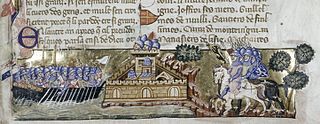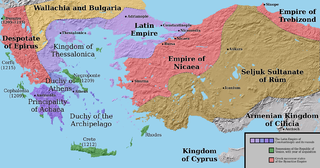 W
WThe Fourth Crusade (1202–1204) was a Latin Christian armed expedition called by Pope Innocent III. The stated intent of the expedition was to recapture the Muslim-controlled city of Jerusalem, by first defeating the powerful Egyptian Ayyubid Sultanate, the strongest Muslim state of the time. However, a sequence of economic and political events culminated in the Crusader army's 1204 sack of Constantinople, the capital of the Greek Christian-controlled Byzantine Empire, rather than Egypt as originally planned. This led to the partitioning of the Byzantine Empire.
 W
WDe la Conquête de Constantinople, is the oldest surviving example of historical French prose, and considered to be one of the most important historical sources on the Fourth Crusade. It was written by Geoffrey of Villehardouin, a knight and crusader, who gave his eyewitness account of the successful conquest of the Christian Byzantine Empire's capital city, Constantinople, on April 13, 1204.
 W
WThe Entry of the Crusaders in Constantinople or The Crusaders Entering Constantinople is a large painting by Eugène Delacroix. It was commissioned by Louis-Philippe in 1838, and completed in 1840. Painted in oil on canvas, it is in the collection of the Musée du Louvre in Paris.
 W
WFulk of Neuilly was a French preacher of the twelfth century, and priest of Neuilly-sur-Marne. His preaching encouraged the Fourth Crusade. He is a beatus of the Roman Catholic Church; his feast is celebrated on March 2.
 W
WThe Byzantine army of the Komnenian era or Komnenian army was the force established by Byzantine emperor Alexios I Komnenos during the late 11th/early 12th century, and perfected by his successors John II Komnenos and Manuel I Komnenos during the 12th century. From necessity, following extensive territorial loss and a near disastrous defeat by the Normans of southern Italy at Dyrrachion in 1081, Alexios constructed a new army from the ground up. This new army was significantly different from previous forms of the Byzantine army, especially in the methods used for the recruitment and maintenance of soldiers. The army was characterised by an increased reliance on the military capabilities of the immediate imperial household, the relatives of the ruling dynasty and the provincial Byzantine aristocracy. Another distinctive element of the new army was an expansion of the employment of foreign mercenary troops and their organisation into more permanent units. However, continuity in equipment, unit organisation, tactics and strategy from earlier times is evident. The Komnenian army was instrumental in creating the territorial integrity and stability that allowed the Komnenian restoration of the Byzantine Empire. It was deployed in the Balkans, Italy, Hungary, Russia, Anatolia, Syria, the Holy Land and Egypt.
 W
WThe Partitio terrarum imperii Romaniae, or Partitio regni Graeci, was a treaty signed among the crusaders after the sack of the Byzantine capital, Constantinople, by the Fourth Crusade in 1204. It established the Latin Empire and arranged the nominal partition of the Byzantine territory among the participants of the Crusade, with the Republic of Venice being the greatest titular beneficiary. However, because the crusaders did not in fact control most of the Empire, with local Byzantine Greek nobles establishing the Byzantine successor kingdoms, most of the crusaders' declared division of the Empire amongst themselves could never be implemented. While the ordeal was a major blow to the Empire, the Empire of Nicaea would, in 1261, retake Constantinople, re-establishing the Byzantine Empire.
 W
WPost miserabile was a papal bull issued by Pope Innocent III on 15 August 1198 calling for the Fourth Crusade in the Holy Land. More than any other crusading bull, it was not issued in response to any single event, such as setback in the East, but was more organisational in tone, foreshadowing the bureaucratic and administrative changes Innocent would make to the crusading institutions.